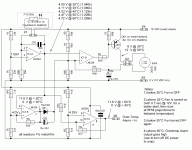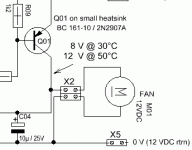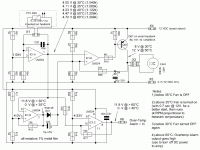Dave S said:II would say it is better than most of the other amps I have built though - AKSA, NCC200, Aleph, JLH 80W mosfet, Borbelly DC100 to name a few.
Hi Dave,
the ncc200 seems to be heralded as a fantastic amp by all, although I've never heard one myself. Can you comment more on the differences between the SKA and the NCC?
Nice review BTW.
Hi Float,
I cannot make a direct comparison because I sold the NCC boards to make way for the GB150s.
From memory the NCC had a slightly darker sound than the GBs, although they are are quite similar in their presentation. Neither could be described as bright or aggressive. Both are capable of handling hf transients properly - bells, cymbals and female vocals without exagerated sibiliance (IMO many amps cannot do this properly).
Maybe they sound similar because they used the same power supply and layout. How much of the sound of an amp is contributed by the power supply and layout?
Sorry for the copout - but in the end it's down to system matching and personal preference.
Cheers,
Dave
I cannot make a direct comparison because I sold the NCC boards to make way for the GB150s.
From memory the NCC had a slightly darker sound than the GBs, although they are are quite similar in their presentation. Neither could be described as bright or aggressive. Both are capable of handling hf transients properly - bells, cymbals and female vocals without exagerated sibiliance (IMO many amps cannot do this properly).
Maybe they sound similar because they used the same power supply and layout. How much of the sound of an amp is contributed by the power supply and layout?
Sorry for the copout - but in the end it's down to system matching and personal preference.
Cheers,
Dave
After some two weeks with my new GB150D I am still awe-struck with every new CD!
The bass is magnificent - weighty, full and punchy - but well extended right down to the bottom octave. The 1812 cannon now sound almost real rather than like popguns! Amazing with only 30Hz bass reflex speakers. Gheorge Zhamphir and Marcel Cellier Improvisations pour Flute De Pan et Orgue (Cellier 003) is simply awesome...
Midrange is smooth, natural and detailed allowing subtle vocal inflections clearly above black hole silence. Notes just crystallise out of the silence... Grace Knight's Fever and Walkin after Midnight are simply rivetting. No accentuated sibilance.
Treble is airy, detailed and spacious allowing perfect holographic 3D images and the raw edge of Hugh Masekela's trumpet...
Piano is one of the most difficult to reproduce accurately... as I listen to Jacques Lousier Trio plays Debussy (Telarc CD83511) it's palpable.. Nojima plays Liszt (Reference recordings RR 25CD)... forget attack and decay... these guys are live in my living room!
This amplifier is just not there.
Well done Greg - an absolute bargain!
Package it in gold and sell it for $25K.
The bass is magnificent - weighty, full and punchy - but well extended right down to the bottom octave. The 1812 cannon now sound almost real rather than like popguns! Amazing with only 30Hz bass reflex speakers. Gheorge Zhamphir and Marcel Cellier Improvisations pour Flute De Pan et Orgue (Cellier 003) is simply awesome...
Midrange is smooth, natural and detailed allowing subtle vocal inflections clearly above black hole silence. Notes just crystallise out of the silence... Grace Knight's Fever and Walkin after Midnight are simply rivetting. No accentuated sibilance.
Treble is airy, detailed and spacious allowing perfect holographic 3D images and the raw edge of Hugh Masekela's trumpet...
Piano is one of the most difficult to reproduce accurately... as I listen to Jacques Lousier Trio plays Debussy (Telarc CD83511) it's palpable.. Nojima plays Liszt (Reference recordings RR 25CD)... forget attack and decay... these guys are live in my living room!
This amplifier is just not there.
Well done Greg - an absolute bargain!
Package it in gold and sell it for $25K.
HiFiddle said:After some two weeks with my new GB150D I am still awe-struck with every new CD!
.......
This amplifier is just not there.
Well done Greg - an absolute bargain!
Package it in gold and sell it for $25K.
Well heard HiFiddle!
Hope you enjoy your SKA more day by day, as I do myself.
BUT,
 do not spoil Gregs generous offering, will you? Tnks.
do not spoil Gregs generous offering, will you? Tnks.stoeffle.
Thank You Stoeffle.
Did I mention the sheer power available from this GB150D - I'm running +/-58V supplies with per channel 160VA transformers and the power seems limitless.
When I cranked it up - my neighbour came over to see who was playing the magnificant piano. She's a piano teacher and she was amazed that it wasn't the real thing. She commented that she'd never heard it reproduced so naturally.
I figure peaks must be close to 400W before transient clipping.
BTW greg has a new website -
http://www.diyhifi.org/amplifierguru/guru_002.htm
I'll do the PSRR mod over the weekend and report back.
Did I mention the sheer power available from this GB150D - I'm running +/-58V supplies with per channel 160VA transformers and the power seems limitless.
When I cranked it up - my neighbour came over to see who was playing the magnificant piano. She's a piano teacher and she was amazed that it wasn't the real thing. She commented that she'd never heard it reproduced so naturally.
I figure peaks must be close to 400W before transient clipping.
BTW greg has a new website -
http://www.diyhifi.org/amplifierguru/guru_002.htm
I'll do the PSRR mod over the weekend and report back.
Attachments
I had a look at Gregs new (?) webpage linked to above. Although I have seen photos of the modules before, I realized one thing I hadn't thought of before. The transistors which I assume to be the bias transistors are TO92, which seem a strange choice since these will be both difficult to attach to the heat sink and will give a poorer thermal contact than many other types. Are these bias transistors, or aren't there any such at all, and these are actually for some other purpose?
I am not trying to reverse engineer the amp, just curious about this. Besides, I think Greg has already revealed most of the important new design tricks in earlier threads.
I am not trying to reverse engineer the amp, just curious about this. Besides, I think Greg has already revealed most of the important new design tricks in earlier threads.
Hi Hifiddle,
do you realise there are two versions of the PSRR mod?
Even then that would require a peak output voltage of 56.7Vpk from +-58Vrails. Are you serious or PMPO?
do you realise there are two versions of the PSRR mod?
that's impossible, unless you are talking square waves.I figure peaks must be close to 400W before transient clipping
Even then that would require a peak output voltage of 56.7Vpk from +-58Vrails. Are you serious or PMPO?
Hi Fryer,
NO!
We agree to keep SKA circuit schematics within the buying community.
If Ampguru wants/allowed to come back and post details then that's up to him.
NO!
We agree to keep SKA circuit schematics within the buying community.
If Ampguru wants/allowed to come back and post details then that's up to him.
Hi Andrew,
I thought Greg had is own page rather than one hosted where it is. I'd say he's tied his wagon to that horse.
-Chris
Thank you. That is quite fair.We agree to keep SKA circuit schematics within the buying community.
I thought Greg had is own page rather than one hosted where it is. I'd say he's tied his wagon to that horse.
-Chris
The PSRR mod is the one Greg asked me to inform DIYaudio of a few weeks ago and I posted on the constructor thread -
http://www.diyaudio.com/forums/showthread.php?postid=942175#post942175
I wanted to build mine in standard form first. I really find it hard to imagine that it can be improved on.
Christer,
On my GB150D the thermal sense TO92 transistors are sunk into snug blind holes in the heatsink. They appear to track the output bias very closely when I have checked at different heatsink temperatures. They control the current in the input stage current sources.
Andrew T,
The power of close to 400W is the instantaneous peak power of a 200W sine wave. Similar to a pulsed sine wave.
FWIW another great review -
http://www.diyhifi.org/forums/viewtopic.php?p=14894#14894
http://www.diyaudio.com/forums/showthread.php?postid=942175#post942175
I wanted to build mine in standard form first. I really find it hard to imagine that it can be improved on.
Christer,
On my GB150D the thermal sense TO92 transistors are sunk into snug blind holes in the heatsink. They appear to track the output bias very closely when I have checked at different heatsink temperatures. They control the current in the input stage current sources.
Andrew T,
The power of close to 400W is the instantaneous peak power of a 200W sine wave. Similar to a pulsed sine wave.
FWIW another great review -
http://www.diyhifi.org/forums/viewtopic.php?p=14894#14894
HiFiddle said:... When I cranked it up - my neighbour came over to see who was playing the magnificant piano. She's a piano teacher and she was amazed that it wasn't the real thing. She commented that she'd never heard it reproduced so naturally...
Sounds like you have a REAL chick magnet there. 😀
I'll have to finish mine. 😉
regards
Greg (not the "real" one)
anatech said:Hi Andrew,
Thank you. That is quite fair.
I thought Greg had is own page rather than one hosted where it is. I'd say he's tied his wagon to that horse.
-Chris
Greg has recently changed his hosting location. It seemed a funny move to me considering the "new" host's strong opinion about commercialism. 😕
It is interesting to note the integrity of the majority of DIYers. I have never been requested to pass on SKA schematics even though I am in communication with many people who would have an interest in them.
regards
hifryer said:
I ............. own a GB300D!
AFAIK the psrr mod only applies to the gb150; the gb300 already has it onboard.
That saves you a job; have a beer instead.
Greg Erskine said:I'll have to finish mine.
The neighbour ?
I'm still regularly stunned that a circuit that looks so simple as the GB150's is able to outperform truckloads of complex stuff from a few audio decades. Finish yours, mate.
(i was hooked on the Erinsborough show from the start of the transmission on the BBC in 1986, curse the BBC that they transmitted an episode a day. Good thing i don't have a piano neighbour sheila)
SKA on small heatsinks with silent fan
Hi, SKA150/300 fans,
perhaps some of you wanted to squeeze the amplifier into a smaller place or onto a smaller heatsink.
SKA purists surely insist on laaaarge heatsinks without annoying fans. But just in case....
To avoid getting in conflict with overheating problems, I found a nice solution for this problem in the latest cct collection of the Elektor magazine (Jul/Aug 2006). Its cct #028 is just the answer to this situation: a cooling fan (12VDC) that stays put & quiet below 35°C heatsink temp and just gets kicked-in at 35C, running proportional to heatsink temp. At 35C with some 8V, going up to full speed at 50C. It switches back into off again when temp goes below 30C.
The cct also outputs an alarm signal (12V), when an alarm situation arouses, bringing the heatsink close to above 60C, which may be used as a shut down signal to turn off DC power to the SKA amp.
I used some of these 120mm x 120mm Papst fans, running at 1250RPM @12V, (very, very quiet!), as well as simple 92mm x 92mm 12V fans from computer stores. They barely whisper, when run at 8V.😀
And, my SKA300 and 150 modules barely get hand-warm, even after a full blown concert CD listening.
A pity I have no nice pianist neighbour looking in for the nice sound....
BOM of the cct, in case the gif pix is not clear:
silent_fan3 BOM:
C01 = 100n ceramic or foil
C02 = 100n ceramic or foil
C03 = 10µ / 25V (radial)
C04 = 10µ / 25V (radial)
D01 = 1N4148
IC1.A..D = LM324
M01 = 12VDC (Fan 12VDC)
NOTE: verify if fan works on voltages from 8..12VDC!
PTC R03 = KTY81/110 (KTY81/110)
Q01 = BC 161-10 / 2N2907A
R01 = 10k (Metal film resistor, 1%)
R02 = 1k0 (Metal film resistor, 1%)
R04 = 390R (Metal film resistor, 1%)
R04 = 390R (Metal film resistor, 1%)
R05 = 82k (Metal film resistor, 1%)
R06 = 4k7 (Metal film resistor, 1%)
R08 = 270k (Metal film resistor, 1%)
R09 = 1k2 (Metal film resistor, 1%)
R10 = 4k7 (Metal film resistor, 1%)
R11 = 2k40 (Metal film resistor, 1%)
R12 = 1k2 (Metal film resistor, 1%)
R13 = 130k (Metal film resistor, 1%)
R14 = 20k0 (Metal film resistor, 1%)
R15 = 12k0 (Metal film resistor, 1%)
R16 = 7k50 (Metal film resistor, 1%)
R17 = 180k (Metal film resistor, 1%)
X1 = (solder terminal, 2 pole)
X2 = (solder/screw terminal, 2 pole)
X4 = (solder/screw terminal, 1 pole)
X5 = (solder/screw terminal, 1 pole)
X6 = (solder/screw terminal, 1 pole)
Thats it.
Nice listening to the SKAs, running just luke-warm when outputting roaring sound levels. Gives them a longer lasting life, due to reduced thermal stresses!
so long,
stoeffle.++++
Hi, SKA150/300 fans,
perhaps some of you wanted to squeeze the amplifier into a smaller place or onto a smaller heatsink.
SKA purists surely insist on laaaarge heatsinks without annoying fans. But just in case....
To avoid getting in conflict with overheating problems, I found a nice solution for this problem in the latest cct collection of the Elektor magazine (Jul/Aug 2006). Its cct #028 is just the answer to this situation: a cooling fan (12VDC) that stays put & quiet below 35°C heatsink temp and just gets kicked-in at 35C, running proportional to heatsink temp. At 35C with some 8V, going up to full speed at 50C. It switches back into off again when temp goes below 30C.
The cct also outputs an alarm signal (12V), when an alarm situation arouses, bringing the heatsink close to above 60C, which may be used as a shut down signal to turn off DC power to the SKA amp.
I used some of these 120mm x 120mm Papst fans, running at 1250RPM @12V, (very, very quiet!), as well as simple 92mm x 92mm 12V fans from computer stores. They barely whisper, when run at 8V.😀
And, my SKA300 and 150 modules barely get hand-warm, even after a full blown concert CD listening.
A pity I have no nice pianist neighbour looking in for the nice sound....
BOM of the cct, in case the gif pix is not clear:
silent_fan3 BOM:
C01 = 100n ceramic or foil
C02 = 100n ceramic or foil
C03 = 10µ / 25V (radial)
C04 = 10µ / 25V (radial)
D01 = 1N4148
IC1.A..D = LM324
M01 = 12VDC (Fan 12VDC)
NOTE: verify if fan works on voltages from 8..12VDC!
PTC R03 = KTY81/110 (KTY81/110)
Q01 = BC 161-10 / 2N2907A
R01 = 10k (Metal film resistor, 1%)
R02 = 1k0 (Metal film resistor, 1%)
R04 = 390R (Metal film resistor, 1%)
R04 = 390R (Metal film resistor, 1%)
R05 = 82k (Metal film resistor, 1%)
R06 = 4k7 (Metal film resistor, 1%)
R08 = 270k (Metal film resistor, 1%)
R09 = 1k2 (Metal film resistor, 1%)
R10 = 4k7 (Metal film resistor, 1%)
R11 = 2k40 (Metal film resistor, 1%)
R12 = 1k2 (Metal film resistor, 1%)
R13 = 130k (Metal film resistor, 1%)
R14 = 20k0 (Metal film resistor, 1%)
R15 = 12k0 (Metal film resistor, 1%)
R16 = 7k50 (Metal film resistor, 1%)
R17 = 180k (Metal film resistor, 1%)
X1 = (solder terminal, 2 pole)
X2 = (solder/screw terminal, 2 pole)
X4 = (solder/screw terminal, 1 pole)
X5 = (solder/screw terminal, 1 pole)
X6 = (solder/screw terminal, 1 pole)
Thats it.
Nice listening to the SKAs, running just luke-warm when outputting roaring sound levels. Gives them a longer lasting life, due to reduced thermal stresses!
so long,
stoeffle.++++
Attachments
Re: SKA on small heatsinks with silent fan
OOOPS,
pse correct fan wiring! sorry....
stoeffle.++++
stoeffle said:Hi, SKA150/300 fans,
......
stoeffle.++++
OOOPS,
pse correct fan wiring! sorry....
stoeffle.++++
Attachments
- Status
- Not open for further replies.
- Home
- Amplifiers
- Solid State
- Simple Killer Amp - Listening impressions




